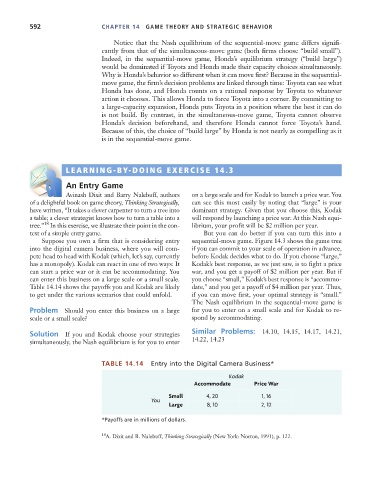Page 618 - Microeconomics, Fourth Edition
P. 618
c14gametheoryandstrategicbehavior.qxd 8/6/10 8:22 AM Page 592
592 CHAPTER 14 GAME THEORY AND STRATEGIC BEHAVIOR
Notice that the Nash equilibrium of the sequential-move game differs signifi-
cantly from that of the simultaneous-move game (both firms choose “build small”).
Indeed, in the sequential-move game, Honda’s equilibrium strategy (“build large”)
would be dominated if Toyota and Honda made their capacity choices simultaneously.
Why is Honda’s behavior so different when it can move first? Because in the sequential-
move game, the firm’s decision problems are linked through time: Toyota can see what
Honda has done, and Honda counts on a rational response by Toyota to whatever
action it chooses. This allows Honda to force Toyota into a corner. By committing to
a large-capacity expansion, Honda puts Toyota in a position where the best it can do
is not build. By contrast, in the simultaneous-move game, Toyota cannot observe
Honda’s decision beforehand, and therefore Honda cannot force Toyota’s hand.
Because of this, the choice of “build large” by Honda is not nearly as compelling as it
is in the sequential-move game.
LEARNING-BY-DOING EXERCISE 14.3
S
D
E
An Entry Game
Avinash Dixit and Barry Nalebuff, authors on a large scale and for Kodak to launch a price war. You
of a delightful book on game theory, Thinking Strategically, can see this most easily by noting that “large” is your
have written, “It takes a clever carpenter to turn a tree into dominant strategy. Given that you choose this, Kodak
a table; a clever strategist knows how to turn a table into a will respond by launching a price war. At this Nash equi-
18
tree.” In this exercise, we illustrate their point in the con- librium, your profit will be $2 million per year.
text of a simple entry game. But you can do better if you can turn this into a
Suppose you own a firm that is considering entry sequential-move game. Figure 14.3 shows the game tree
into the digital camera business, where you will com- if you can commit to your scale of operation in advance,
pete head to head with Kodak (which, let’s say, currently before Kodak decides what to do. If you choose “large,”
has a monopoly). Kodak can react in one of two ways: It Kodak’s best response, as we just saw, is to fight a price
can start a price war or it can be accommodating. You war, and you get a payoff of $2 million per year. But if
can enter this business on a large scale or a small scale. you choose “small,” Kodak’s best response is “accommo-
Table 14.14 shows the payoffs you and Kodak are likely date,” and you get a payoff of $4 million per year. Thus,
to get under the various scenarios that could unfold. if you can move first, your optimal strategy is “small.”
The Nash equilibrium in the sequential-move game is
Problem Should you enter this business on a large for you to enter on a small scale and for Kodak to re-
scale or a small scale? spond by accommodating.
Solution If you and Kodak choose your strategies Similar Problems: 14.10, 14.15, 14.17, 14.21,
simultaneously, the Nash equilibrium is for you to enter 14.22, 14.23
TABLE 14.14 Entry into the Digital Camera Business*
Kodak
Accommodate Price War
Small 4, 20 1, 16
You
Large 8, 10 2, 12
*Payoffs are in millions of dollars.
18 A. Dixit and B. Nalebuff, Thinking Strategically (New York: Norton, 1991), p. 122.

